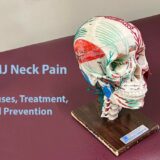Myofascial Pain Syndrome

What is Myofascial Pain Syndrome?
Myofascial pain syndrome (MPS), also known as chronic myofascial pain (CMP), is a syndrome characterized by chronic pain caused by multiple trigger points and fascial constrictions. Characteristic features of a myofascial trigger point include: focal point tenderness, reproduction of pain upon trigger point palpation, hardening of the muscle upon trigger point palpation, pseudo-weakness of the involved muscle, referred pain, and limited range of motion following approximately 5 seconds of sustained trigger point pressure.
Myofascial pain syndrome (MPS)
When referencing Myofascial pain syndrome, it is referring to patients with persistent musculoskeletal pain issues. It is a painful condition originating from muscle and surrounding fascia. Patients typically report localized pain in a restricted area or referred pain of various patterns. Orofacial pain specialist who perform physical examinations of such patient typically discover trigger points (TrPs) on the involved muscles. MPS can be present in acute and chronic pain types. Acute MPS frequently resolves on its own or after simple treatments. However, patients with chronic MPS are usually worse in prognosis.
Chronic Myofascial Pain or (CMP)
Know as CMP for easy reference, Chronic Myofascial Pain is more serious as the name implies. It involves pain that is severe, or long lasting, and is associated with specific trigger points. CMP is more often found in people between the ages of 30 and 60 years. Recovery time also varies by a person severity level. Commonly, symptoms resolve after a few weeks. However, some patients who have progressed to chronic MPS find that it persists for 6 months or longer. Additionally, patients with chronic MPS have more widespread pain than the acute form.
Treatment for myofascial pain syndrome or CMP typically includes prescribed medications, trigger point injections, and or physical therapy. Conclusive evidence is still lacking that supports using one treatment plan over others. It is widely agreed that exercise is considered an essential component of any myofascial pain treatment program.
The following are commonly used:
- Therapy: one therapy, for example, is dry needling. This is when the doctor uses a thin needle into and around the trigger point.
- Stretching: Your treating physician or pain specialist may use this in tandem with other therapies, such as dry needling and ultrasound.
- Posture training: This is considered a behavior modification that adjusts and improved the patient’s daily habits.
- Massage: Some people report that passive rhythmic, active rhythmic, and trigger point pressure helps to release their pain.
- Heat: Hot compresses may be tried. Applying heat soothes constricted and throbbing muscles by dilating local blood vessels. Heat increases the blood flow to the painful area where applied.
- Ultrasound: A process of using sound waves to penetrate soft tissues to see if it gives the myofascial pain patient relief.
- Another type of therapy called Cold laser, or low-level light therapy. This is when the trigger point is exposed to near-infrared light.
Many of the myofascial pain syndrome treatments are focused on myofascial pain trigger points.
A person can have myofascial pain along with another medical condition. Self-diagnosis is not advised. It is especially important to consult with a medical specialist who can diagnose the difference symptoms, and sort one medical condition from the other in order to apply the proper treatments for each condition.
what is Myofascial Neck Pain?
“Cervical myofascial pain syndrome is a condition in which the layer of connective tissue that surrounds your neck muscles (fascia) becomes tight or damaged. The result is often: Tight or achy neck muscles that may limit your range of motion”, according to the spine-health.com.
The Minnesota Pain and Neck Care Clinic provides myofascial release therapy, among other pain relief treatments. This therapy relies on gentle direct pressure and long stretching strokes on pre-identified trigger points. Our Minnesota physical therapy pain specialists measure progress by seeing if your range of motion and functionality increases. As well, we closely monitor what helps your pain decrease.
Related Readings:
Myofascial Pain Integrated Self-care Treatment
What is a Pain Disorder?
Orofacial Pain Specialty


